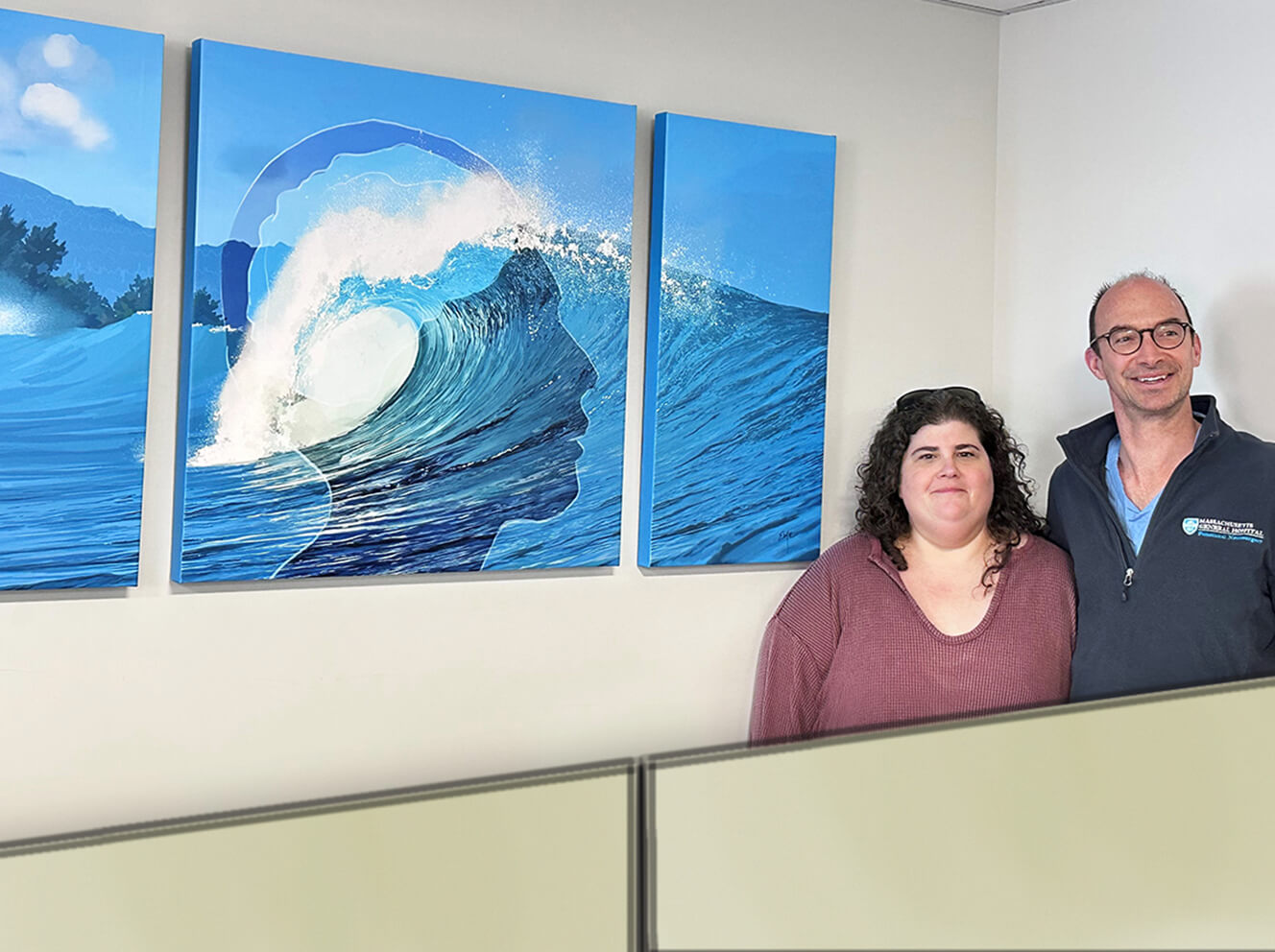For much of her life, Emily Kalina, 44, suffered from seizures that were difficult to control. After spending her twenties in and out of hospitals, her doctors finally found a cocktail of medications that controlled her epilepsy — until they didn’t.
Epilepsy is one of the most common neurological diseases worldwide, affecting approximately 50 million people. Despite the availability of many medications, epilepsy remains incompletely controlled in at least 30% of patients.
For Emily, the worst of it began during her last year at Rhode Island School of Design where she pursued painting and was preparing for a career in graphic design. While she walked with her class at her graduation, she had a tonic-clonic seizure (formerly known as a “grand mal” seizure) during the processional. A tonic-clonic seizure causes loss of consciousness and violent muscle contractions. There is often no warning for patients that one is imminent, and short-term memory can be impaired.
“A half an hour felt like a lifetime when I didn’t know how I ended up on the ground, why I didn’t recognize anyone or anything,” Emily says. “I was in a state of pure, primal fear. It was the stuff of nightmares.”
Unpredictable Seizures Placed Independence Out of Reach
For 14 years after college, Emily managed to control her seizures with medication, despite debilitating side effects. Eventually, Emily’s tonic-clonic seizures returned, right at the time when she was getting ready to launch her own art business.
“Painting has always provided me with a creative outlet, and I was building a successful graphic design business,” Emily says. “But just as I was on the verge of independence, I had enormous restrictions placed on my life.”
An Implant Brings New Opportunities
In her search to avoid adding more medication to her epilepsy management plan, Emily learned about Massachusetts General Hospital’s Responsive Neurostimulator implant program, led by neurosurgeon Mark Richardson, MD, PhD, adult epileptologist Sydney Cash, MD, PhD, and pediatric epileptologist Catherine Chu, MD. Mass General pioneered the use of this implant and was the first to use it in a patient with generalized epilepsy.
“We have been able to help many patients with epilepsy by removing the section of the brain that causes the seizures,” Dr. Richardson says. “But, in patients with idiopathic generalized epilepsy, like Emily, we cannot identify a specific spot, so traditional surgery is not an option.”
“Over time, the [NeuroPace Responsive Neurostimulator] reeducates the neural pathways, retraining the brain to have fewer seizures.”
The NeuroPace Responsive Neurostimulator (RNS) is a battery-operated device that detects electrical activity in the brain and then responds with electrical stimulation when a seizure is detected. “Over time, the RNS reeducates the neural pathways, retraining the brain to have fewer seizures,” Dr. Richardson says.
The device is FDA-approved for some types of epilepsy, but still under review for broader use. Dr. Cash says he carefully considers each patient’s unique case before deciding whether they are a good candidate for implantation.
“These devices are different than medication,” he says. “Patients must download data daily to a laptop computer we provide, and then transmit the data to a central server. Patients must be willing to do that consistently.” Dr. Cash describes how his team makes every effort to make this work for every candidate, helping patients with everything from connecting to the internet and installing a router to going to a public library with internet or having a friend connect the device.
Teaching the Brain to Cope With a Seizure
Emily was eager to try the implant. Once she was approved for the procedure, and Dr. Richardson implanted the device, she met with Dr. Cash several times as he made adjustments.
“The care our team provided to this patient, combined with scientific expertise, represents exactly the kind of research-informed, compassionate care that is our goal here at Mass General,” says Andrew J. Cole, MD, Director of the Epilepsy Service.
After receiving her implant, Emily says, things changed. “I started experiencing what felt like an aura, or even the beginnings of a seizure,” she says. “Then I felt something new. It felt like a train was switching from one set of tracks to another, enabling the same train to go to a different destination. I went on with my day and that aura never escalated into a full-blown seizure.”
Since then, Emily says her seizures have been reduced by 100% and her art business is thriving.
A New Phase of Life
“I feel like I’m emerging from more than two decades of fog and am embarking on an entirely new phase of my life. For the first time in a long time, I can look ahead and make plans,” Emily says.
While the success of the implant is exciting, the team at Mass General is not stopping their research anytime soon. “The Holy Grail of epilepsy treatment for individuals like Emily is to detect abnormal electrical signals in the brain before a seizure happens, and we have an NIH-funded project to develop RNS treatment biomarkers,” Dr. Richardson says.
“Dr. Richardson has been at the forefront of this life-changing procedure,” says Bob Carter, MD, PhD, Chief of Neurosurgery at Mass General. “Philanthropic support allows clinician-scientists like Drs. Richardson and Cash to explore new possibilities to improve the treatments we can offer.”
To learn how you can support the next generation of epilepsy treatments, please contact us.
“I feel like I’m emerging from more than two decades of fog and am embarking on an entirely new phase of my life. For the first time in a long time, I can look ahead and make plans.”







